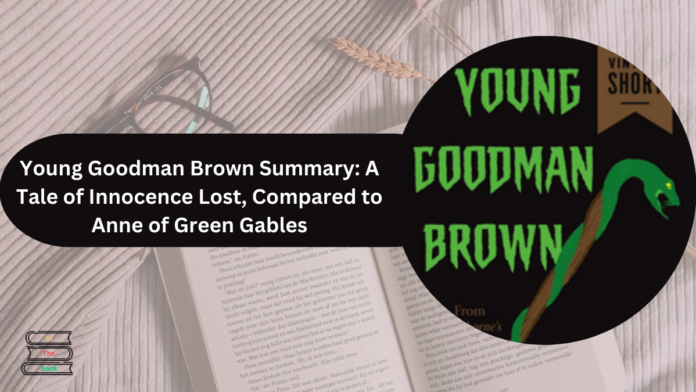Young Goodman Brown summary is a thought-provoking tale that explores the complexities of human nature, written by Nathaniel Hawthorne. The story follows the journey of Young Goodman Brown, a devout Puritan, who embarks on a perilous journey into the forest, leaving behind his wife, Faith. As he ventures deeper into the woods, he encounters various townspeople, including the minister and his wife, engaging in a witches’ Sabbath. The Young Goodman Brown summary provides a rich exploration of themes such as Faith, guilt, and the duality of human nature.
Contents
Young Goodman Brown Summary: A Descent into Darkness
The story begins with Young Goodman Brown saying goodbye to his wife, Faith, as he starts his journey. He is determined to resist the devil’s temptations, but as he walks deeper into the forest, he encounters various obstacles that test his Faith. He meets an older man who resembles the devil and is shocked to see his fellow townspeople, including the minister and his wife, participating in a witches’ Sabbath. Brown’s encounter with the devil and his realization that evil is pervasive in society shakes his Faith and innocence.
The Symbolism of the Forest
The forest in Young Goodman Brown serves as a symbol of the unknown, representing the darkness and evil that lies within human nature. Brown’s journey into the forest represents the heart of darkness, where he confronts the evil he had previously denied. The forest also symbolizes the wilderness of human nature, where the rules of society do not apply. It is in this untamed, chaotic environment that Brown encounters the true nature of humanity.
The Character of Young Goodman Brown
Young Goodman Brown is a complex character, representing the contradictions of human nature. He is a devout Puritan but also curious and tempted by the devil. His journey into the forest represents his inner struggle between good and evil. Through Brown’s character, Hawthorne explores the idea that human nature is inherently flawed and that we all have the capacity for evil. Brown’s descent into the forest is a physical and metaphorical journey into his soul, revealing the darkness within.
The Theme of Guilt and Shame
Young Goodman Brown explores the theme of guilt and shame as he grapples with the darkness and the evil surrounding him. His encounter with the devil and his realization that evil is pervasive in society fills him with guilt and shame. The story highlights the destructive power of guilt and shame as Brown becomes increasingly isolated and withdrawn. His inability to reconcile his Faith with the reality of human nature leads to a life of suspicion and despair.
The Significance of Faith
Faith, Brown’s wife, serves as a symbol of innocence and purity. Her name represents the Faith that Brown has lost, and her presence in the story serves as a reminder of the goodness Brown abandoned. Through Faith’s character, Hawthorne highlights the importance of Faith and innocence in human nature. Faith’s symbolic role underscores the tension between spiritual belief and the corruptibility of the human soul. Her pink ribbons, a recurring motif in the story, symbolize the fragility and loss of innocence.
The Impact of Brown’s Journey
The consequences of Brown’s journey are profound and long-lasting. After witnessing the apparent corruption of his community, Brown returns home a changed man. His Faith in humanity is shattered, and he becomes distrustful and cynical. The once naive and hopeful Goodman Brown is now haunted by what he perceives as the ubiquitous presence of evil. This transformation illustrates Hawthorne’s commentary on the potential for disillusionment and the loss of innocence that can result from confronting the darker aspects of human nature.
Hawthorne’s Critique of Puritanism
Through Young Goodman Brown, Hawthorne offers a critique of Puritanism and its rigid moral framework. The story suggests that the Puritans’ strict, black-and-white worldview failed to account for the complexities and dualities of human nature. By portraying even the most pious members of the community as susceptible to sin, Hawthorne challenges the notion of inherent righteousness and highlights the potential hypocrisy within religious institutions. Brown’s disillusionment reflects the limitations of a worldview that cannot reconcile the coexistence of good and evil within individuals.
The Legacy of Young Goodman Brown
Young Goodman Brown remains a powerful and enduring work of literature due to its exploration of timeless themes and rich symbolism. The story’s examination of Faith, guilt, and the duality of human nature continues to resonate with readers. Hawthorne’s masterful use of allegory and his ability to evoke a sense of moral ambiguity ensure that the tale remains relevant and thought-provoking. The journey of Young Goodman Brown serves as a cautionary tale about the dangers of losing one’s Faith and the destructive impact of guilt and shame.
Conclusion
In conclusion, Young Goodman Brown’s summary is a haunting and thought-provoking tale that explores the complexities of human nature. Through Brown’s journey into the heart of darkness, Hawthorne highlights the destructive power of guilt and shame and the importance of Faith and innocence. The story serves as a reminder that human nature is inherently flawed and that we all have the capacity for evil. By examining the inner turmoil of its protagonist, Young Goodman Brown offers a profound commentary on the duality of humanity and the challenges of maintaining one’s Faith in a world filled with moral ambiguity.
Click Here To Read More

Ross, an exam specialist with a passion for education, writes comprehensive articles on exam results and admit cards. His expertise ensures students receive reliable information and useful tips to excel in their exams.



























